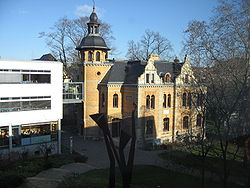
Max Planck Institute of Economics
Encyclopedia

Eastern Europe
Eastern Europe is the eastern part of Europe. The term has widely disparate geopolitical, geographical, cultural and socioeconomic readings, which makes it highly context-dependent and even volatile, and there are "almost as many definitions of Eastern Europe as there are scholars of the region"...
an socialist
Socialism
Socialism is an economic system characterized by social ownership of the means of production and cooperative management of the economy; or a political philosophy advocating such a system. "Social ownership" may refer to any one of, or a combination of, the following: cooperative enterprises,...
economic systems, but it now researches a broad set of problems relating to change in modern economies more generally, including evolutionary economics
Evolutionary economics
Evolutionary economics is part of mainstream economics as well as heterodox school of economic thought that is inspired by evolutionary biology...
, experimental economics
Experimental economics
Experimental economics is the application of experimental methods to study economic questions. Data collected in experiments are used to estimate effect size, test the validity of economic theories, and illuminate market mechanisms. Economic experiments usually use cash to motivate subjects, in...
, and entrepreneurial studies. The institute is one of 80+ research institutes of the Max Planck Society
Max Planck Society
The Max Planck Society for the Advancement of Science is a formally independent non-governmental and non-profit association of German research institutes publicly funded by the federal and the 16 state governments of Germany....
(Max Planck Gesellschaft) and is located in Jena
Jena
Jena is a university city in central Germany on the river Saale. It has a population of approx. 103,000 and is the second largest city in the federal state of Thuringia, after Erfurt.-History:Jena was first mentioned in an 1182 document...
.
It is organized into three research units:
- Evolutionary Economics Group (director: Ulrich WittUlrich WittUlrich Witt is a German economist and Director of the Evolutionary Economics Group at the Max Planck Institute of Economics in Jena . He also holds an honorary professorship at the Friedrich Schiller University...
), - Strategic Interaction Group (director: Werner Güth)
- Entrepreneurship, Growth and Public Policy Group (director: David B. AudretschDavid B. AudretschDavid Bruce Audretsch is an American economist. He was the director of the research unit Entrepreneurship, Growth and Public Policy Group at the Max Planck Institute of Economics Jena in Germany until August 31, 2009...
).
The institute is located in the Kahlaische Strasse, about 1 km south-east of the city centre. It is housed in an attractively restored Victorian
Victorian architecture
The term Victorian architecture refers collectively to several architectural styles employed predominantly during the middle and late 19th century. The period that it indicates may slightly overlap the actual reign, 20 June 1837 – 22 January 1901, of Queen Victoria. This represents the British and...
villa, linked by a glass bridge to a much larger modern building, which includes offices and other facilities for each of the research units, each unit having one floor of the main section of the building. In addition the new buildings include a substantial library, and apartments where visitors to the institute can be accommodated.

